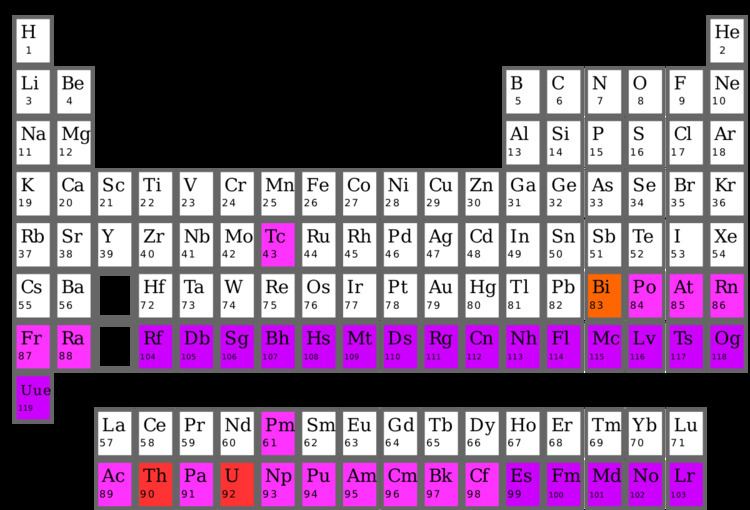 | ||
In chemistry, a synthetic element is a chemical element that does not occur naturally on Earth, and can only be created artificially. So far, 24 synthetic elements have been created (those with atomic numbers 95–118). All are unstable, decaying with half-lives ranging from 15.6 million years to a few hundred microseconds.
Contents
- Properties
- History
- List of synthetic elements
- Other elements usually produced through synthesis
- References
Seven other elements were first created artificially and thus considered synthetic, but later discovered to exist naturally (in trace quantities) as well; among them plutonium—first synthesized in 1940—the one best known to laypeople, because of its use in atomic bombs and nuclear reactors.
Properties
Synthetic elements are radioactive and decay rapidly into lighter elements—possessing half-lives so short, relative to the age of Earth (which formed approximately 4.6 billion years ago), that any atoms of these elements that may have existed when the Earth formed have long since decayed. Atoms of synthetic elements only occur on Earth as the product of atomic bombs or experiments that involve nuclear reactors or particle accelerators, via nuclear fusion or neutron absorption.
Atomic mass for natural life is based on weighted average abundance of natural isotopes that occur in Earth's crust and atmosphere. For synthetic elements, the isotope depends on the means of synthesis, so the concept of natural isotope abundance has no meaning. Therefore, for synthetic elements the total nucleon count (protons plus neutrons) of the most stable isotope, i.e. the isotope with the longest half-life—is listed in brackets as the atomic mass.
History
The first element discovered through synthesis was technetium—its discovery being definitely confirmed in 1936. This discovery filled a gap in the periodic table, and the fact that no stable isotopes of technetium exist explains its natural absence on Earth (and the gap). With the longest-lived isotope of technetium, Tc-98, having a 4.2-million-year half-life, no technetium remains from the formation of the Earth. Only minute traces of technetium occur naturally in the Earth's crust—as a spontaneous fission product of uranium-238 or by neutron capture in molybdenum ores—but technetium is present naturally in red giant stars.
The first discovered synthetic element was curium, synthesized in 1944 by Glenn T. Seaborg, Ralph A. James, and Albert Ghiorso by bombarding plutonium with alpha particles. The discoveries of americium, berkelium, and californium followed soon. Einsteinium and fermium were discovered by a team of scientists led by Albert Ghiorso in 1952 while studying the radioactive debris from the detonation of the first hydrogen bomb. The isotopes discovered were einsteinium-253, with a half-life of 20.5 days, and fermium-255, with a half-life of about 20 hours.
The discoveries of mendelevium, nobelium, lawrencium followed. During the height of the Cold War, the Soviet Union and United States independently discovered rutherfordium and dubnium. The naming and credit for discovery of those elements remained unresolved for many years but eventually shared credit was recognized by IUPAC/IUPAP in 1992. In 1997, IUPAC decided to give dubnium its current name honoring the city of Dubna where the Russian team made their discoveries since American-chosen names had already been used for many existing synthetic elements, while the name rutherfordium (chosen by the American team) was accepted for element 104.
No element with an atomic number greater than 99 has any use outside of scientific research, as they have extremely short half-lives.
List of synthetic elements
The following elements do not occur naturally on Earth. All are transuranium elements and have atomic numbers of 95 and higher.
Other elements usually produced through synthesis
All elements with atomic numbers 1 through 94 are naturally occurring at least in trace quantities, but the following elements are often produced through synthesis. Except for polonium, francium, actinium, and protactinium, they were all discovered through synthesis before being found in nature.
